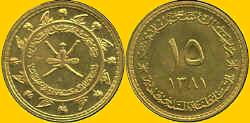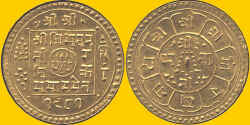This is the Worldwide Numismatics Website!
This is a modest collection of second millennium gold coins
Click the thumbnail picture to see a larger version of the picture, then use your browser BACK button to return to the original page you were viewing.
MOROCCO
From the dawn of history, Morocco has been populated. Phoenicians came to trade and settle, then successive waves of Romans, Vandals, Visigoths, and Byzantine Creeks arrived to dominate and rule.Arabs began bringing their civilization in the 7th century, and the Alaouite dynasty, which claims descent from the Prophet Mohammed, has ruled Morocco since 1649. The Portuguese controlled the Atlantic coast in the 15th century and the French arrived in 1830. In 1904 Morocco was divided into spheres of French and Spanish influence and a 1912 treaty established these zones as protectorates. Morocco began to assert its independence after World War II with the formation of the Istiqlal (Independence) Party. Active opposition to foreign domination erupted in 1953 after France deposed the highly respected Sultan Muhammad V and replaced him with his unpopular uncle. France allowed Muhammad V to return in 1955 and granted political independence on 2 March 1956. In 1956 and 1958, Morocco gained authority over the Spanish-controlled areas except two enclaves Ceuta and Melilla and over the city of Tangier, an international zone since 1923.
250 Dinars - 1977
KM-066 - 6,45 g - 20,8 mm
Edge
- Reeded
Mintage - 3.000
This coin was struck by the British Royal Mint to commemorate the King's birthday. The obverse features King al-Hassan II (b1929-d1999) with an Arabic legend on both sides of the bust. The reverse has the royal arms with Arabic legends at topo and bottom. The dates 1977 and 1397 are to the sides and the denomination 250 is at the bottom.
MUSCAT & OMAN
Oman´s history goes back to the very dawn of civilization. The coastal area fronting on the Gulf of Oman is believed to have been the land known to the Sumerians as Magan, from which as early as 3,000 B.C. they were importing copper. Remains of settlements and distinctive beehive tombs are the legacy of this earliest known culture. The Arab history of the country begins in the 2nd century B.C., with the migration of tribal groups from the region of modern-day Yemen. The Omanis were among the first of the peoples of the Arabian Peninsula to embrace Islam, doing so during the 7th century A.D. The centuries that followed were a golden age, with Omani sailors and traders ranging from India to Africa. In 1507 the Portuguese seized and fortified Muscat harbor, establishing a string of coastal strong points to protect their trade route to India. They were not finally expelled until 1650. The Omanis then proceeded to build their own empire on the Arabian Peninsula and along the coasts of Persia, India and Africa, becoming the dominant maritime power in the area. In 1741 the founder of the present Al-Said dynasty, Imam Ahmad bin Said, took power, moving the capital from the interior to the former Portuguese stronghold of Muscat. The country thereafter was known as Muscat and Oman. Winning a contest with France for influence, Britain established a treaty relationship with the sultanate in 1798. Oman was recognized as fully independent in 1951, but the close relationship continued.
15 Saidi Riyals - 1381 AH
KM-035
- 7,99 g
Mintage - 2.000
This coin was issued by Muscat and Oman. The obverse features the royal arms surrounded by an Arabic legend within a circle. Outside the circle are alternate images of a dhow and a date palm. The reverse has the denomination 15 and the date 1381 within an Arabic legend.
NEPAL
Nepal's recorded history began with the Kiratis, who arrived in the 7th or 8th century BC from the east. Little is known about them. It was during this period that Buddhism first came to the country. By 200 AD, Buddhism had waned, and was replaced by Hinduism, brought by the Licchavis, who invaded from northern India and overthrew the last Kirati king. The Hindus also introduced the caste system (which still continues today). By 879, the Licchavi era had waned and was succeeded by the Thakuri dynasty. A grim period of instability and invasion often referred to as the 'Dark Ages' followed, but Kathmandu Valley's strategic location ensured the kingdom's survival and growth. The rulers of Ghorkha launched a campaign to conquer the valley. In 1768 after 27 years of fighting they triumphed and moved their capital to Kathmandu. From this new base the kingdom's power expanded, borne by a seemingly unstoppable army, until progress was halted in 1792 by a brief and chastening war with Tibet. Further hostilities followed in 1814, this time with the British over a territorial dispute. The Nepalese were eventually put to heel and compelled to sign the 1816 Sugauli Treaty, which surrendered Sikkim and most of Terai (some of the land was eventually restored in return for Nepalese help in quelling the Indian Mutiny of 1857), established Nepal's present eastern and western boundaries and installed a British resident in the country. The Shah dynasty continued in power during the first half of the 19th century until the ghastly Kot Massacre of 1846. Taking advantage of the intrigue and assassinations that had plagued the ruling family, Jung Bahadur seized control by butchering several hundred of the most important men while they assembled in the Kot courtyard. He took the more prestigious title Rana, proclaimed himself prime minister for life, and later made the office hereditary. The Rana's regime came to an end soon after WW II. In 1948, the British withdrew from India and with them went the Ranas' chief support. King Tribhuvan was anointed ruler in 1951 and struck up a government comprised of Ranas and members of the newly formed Nepali Congress Party. But the compromise was shortlived. After toying with democratic elections, King Mahendra (Tribhuvan's son and successor) decided that a 'partyless' panchaayat system would be more appropriate for Nepal. The king selected the prime minister and cabinet and appointed a large proportion of the national assembly, which duly rubber-stamped his policies. In 1989, the Nepalese rose up in popular protest called the Jana Andolan or 'People's Movement'. In the ensuing months, detention, torture and violent clashes left hundreds of people dead. It all proved too much for King Birendra, in power since 1972. He dissolved his cabinet, legalised political parties and invited the opposition to form an interim government. The panchaayat system was finally laid to rest. The changeover to democracy proceeded in an orderly but slow fashion.
1
Mohar - 1981VS (1924)
KM-702 -
5,60 g
The coin was issued by Tribhuvana Vira Vikrama who
ruled from 1911 to 1950 AD. The obverse features inscriptions in Sanskrit
in the square (Shri Tribhuvana Vira Vikrama) with the date (1981) at the bottom.
The reverse pictures a central inscription (Shri 3 Bhavani) surrounded by
a paneled legend (Shri Shri Shri ?).
There
are more Nepalese gold coins in this section if you are interested - Page
Nepal 1
NETHERLANDS
The Netherland's early history is linked with Belgium and Luxembourg; the three were known as the 'Low Countries' until the 16th century when the present-day Netherlands' boundaries were roughly drawn. Originally the land was inhabited by tribal groups: the Germanic Batavi drained the sea lagoons while the Frisii lived on mounds in the remote north. In the late 16th century the region's northern provinces, inhabited by recent converts to Protestantism, united to fight the Catholic Spanish rulers. Philip II of Spain sent the cruel Inquisition to enforce Catholicism, and war broke out in 1568. The revolt of the Netherlands was led by Prince William of Orange, nicknamed William the Silent for his refusal to enter into religious arguments. After 80 years of conflict Holland and its allied provinces expelled the Spaniards in 1648, and Holland became synonymous with the independent country that emerged in this corner of Europe. In 1795 the French invaded and Napoleon appointed his younger brother Louis as king. When the largely unpopular French occupation came to an end, the United Kingdom of the Netherlands - incorporating Belgium and Luxembourg was born. The first king, King William I of Orange, was crowned in 1814, and the House of Orange rules to this day.
1
Ducat - 1809
KM-038
- 3,50 g
Mintage 2,371M
The obverse depicts a bareheaded bust of King
Louis Napoleon (b1778-d1846) surrounded by the Dutch legend LODEW. NAP. KON. VAN
HOLL. (Lodewig Napoleon King of Holland). He
was appointed King of Holland and served from 1806 to 1820. His son Louis
Napoleon II became French emperor in 1862. The reverse has the
royal arms of the Kingdom of Holland surrounded by the Dutch legend
KONINGRIJK HOLLAND (Kingdom of Holland) with the date 1809 below the arms..
There are more Dutch gold coins in this section if you are interested - Page Netherlands 1
NETHERLANDS ANTILLES
The
Netherlands Antilles group, of which Curaçao is the largest and most
prosperous, was first encountered by Europeans in 1499, when Alonso de Ojmeda
– one of Columbus’ lieutenants – reached the island. It was settled by the
Spanish, in the early 1500s, who retained possession until the Dutch East India
Company seized it in 1634. Thousands of slaves were then imported to provide
labour for the island group’s plantation agricultural schemes. In the early
19th century, persistent attacks by the British and French destabilised the
island for a while; at one point it was even leased to a New York merchant. By
1816, the Dutch had reasserted control and introduced further plantations. The
abolition of slavery in 1863 set off a long period of economic decline, relieved
in 1916, by the opening of an oil refinery.
200 Gulden - 1976
KM-016
- 7,95 g
Edge - Lettered
Mintage - 0,015M
This NCLT "coin" commemorate the 200th Anniversary of USA Independence. The obverse pictures Queen Juliana of The Netherlands (b1909-). Juliana abdicated in 1980 in favour of her daughter Beatrix who is the current Queen. The legend JULIANA REGINA - NEDERLANDSE ANTILLEN (Juliana Queen (in Latin) and Netherlands Antilles (in Dutch)) surround the bust. The date 1976 is below the bust. The reverse has the ship ANDREW DORIA with flags in either side. The years 1779-1976 are at the top and the denomination 200 G is below. The legend 900/100 FINE GOLD is along the left edge below the denomination. The lettered edge says FIRST AMERICAN FLAG.
If you would like to see additional gold coins, please click here - Page 23
f you want to return to the home page, please click here - Home


